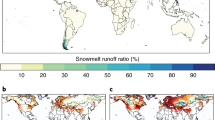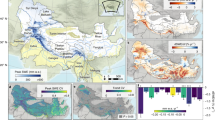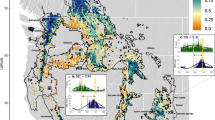Abstract
In a warming climate, precipitation is less likely to occur as snowfall1,2. A shift from a snow- towards a rain-dominated regime is currently assumed not to influence the mean streamflow significantly1,3,4,5. Contradicting the current paradigm, we argue that mean streamflow is likely to reduce for catchments that experience significant reductions in the fraction of precipitation falling as snow. With more than one-sixth of the Earth’s population depending on meltwater for their water supply3 and ecosystems that can be sensitive to streamflow alterations6, the socio-economic consequences of a reduction in streamflow can be substantial. By applying the Budyko water balance framework7 to catchments located throughout the contiguous United States we demonstrate that a higher fraction of precipitation falling as snow is associated with higher mean streamflow, compared to catchments with marginal or no snowfall. Furthermore, we show that the fraction of each year’s precipitation falling as snowfall has a significant influence on the annual streamflow within individual catchments. This study is limited to introducing these observations; process-based understanding at the catchment scale is not yet provided. Given the importance of streamflow for society, further studies are required to respond to the consequences of a temperature-induced precipitation shift from snow to rain.
This is a preview of subscription content, access via your institution
Access options
Subscribe to this journal
Receive 12 print issues and online access
$209.00 per year
only $17.42 per issue
Buy this article
- Purchase on Springer Link
- Instant access to full article PDF
Prices may be subject to local taxes which are calculated during checkout


Similar content being viewed by others
References
Solomon, S (eds) et al. Climate Change 2007: The Physical Science Basis (ed Solomon, S. et al.) (Cambridge Univ. Press, 2007).
Kapnick, S. & Hall, A. Causes of recent changes in western North American snowpack. Clim. Dyn. 38, 1885–1899 (2012).
Barnett, T. P., Adam, J. C. & Lettenmaier, D. P. Potential impacts of a warming climate on water availability in snow-dominated regions. Nature 438, 303–309 (2005).
Regonda, S. K., Rajagopalan, B., Clark, M. & Pitlick, J. Seasonal cycle shifts in hydroclimatology over the western US. J. Clim. 18, 372–384 (2005).
Stewart, I. T., Cayan, D. R. & Dettinger, M. D. Changes toward earlier streamflow timing across western North America. J. Clim. 18, 1136–1155 (2005).
Bunn, S. E. & Arthington, A. H. Basic principles and ecological consequences of altered flow regimes for aquatic biodiversity. Environ. Manag. 30, 492–507 (2002).
Budyko, M. I. & Miller, D. H. Climate and Life Vol 508 (Academic, 1974).
Milly, P. C. D. et al. Stationarity is dead: Whither water management? Science 319, 573–574 (2008).
Koutsoyiannis, D. HESS opinions ‘A random walk on water’. Hydrol. Earth Syst. Sci. 14, 585–601 (2010).
Laternser, M. & Schneebeli, M. Long-term snow climate trends of the Swiss Alps (1931–99). Int. J. Climatol. 23, 733–750 (2003).
Hamlet, A. F., Mote, P. W., Clark, M. P. & Lettenmaier, D. P. Effects of temperature and precipitation variability on snowpack trends in the Western US. J. Clim. 18, 4545–4561 (2005).
Mote, P. W., Hamlet, A. F., Clark, M. P. & Lettenmaier, D. P. Declining mountain snowpack in western North America. Bull. Am. Meteorol. Soc. 86, 39–49 (2005).
Barnett, T. P. et al. Human-induced changes in the hydrology of the western US. Science 319, 1080–1083 (2008).
Godsey, S. E., Kirchner, J. W. & Tague, C. L. Effects of changes in winter snowpacks on summer low flows: Case studies in the Sierra Nevada, California, USA. Hydrological Processes http://dx.doi.org/10.1002/hyp.9943 (2013).
Cayan, D. R., Dettinger, M. D., Kammerdiener, S. A., Caprio, J. M. & Peterson, D. H. Changes in the onset of spring in the western US. Bull. Am. Meteorol. Soc. 82, 399–415 (2001).
Williams, C. A. et al. Climate and vegetation controls on the surface water balance: Synthesis of evapotranspiration measured across a global network of flux towers. Water Resour. Res. 48, W06523 (2012).
Milly, P. C., Dunne, K. A. & Vecchia, A. V. Global pattern of trends in streamflow and water availability in a changing climate. Nature 438, 347–350 (2005).
Bosson, E., Sabel, U., Gustafsson, L. G., Sassner, M. & Destouni, G. Influences of shifts in climate, landscape, and permafrost on terrestrial hydrology. J. Geophys. Res. 117, D05120 (2012).
Zhang, L., Dawes, W. R. & Walker, G. R. Response of mean annual evapotranspiration to vegetation changes at catchment scale. Wat. Resour. Res. 37, 701–708 (2001).
Destouni, G., Jaramillo, F. & Prieto, C. Hydroclimatic shifts driven by human water use for food and energy production. Nature Clim. Change 3, 213–217 (2012).
Groisman, P. Y. et al. Contemporary changes of the hydrological cycle over the contiguous US: Trends derived from in situ observations. J. Hydrometeorol. 5, 64–85 (2004).
Jarsjö, J., Asokan, S. M., Prieto, C., Bring, A. & Destouni, G. Hydrological responses to climate change conditioned by historic alterations of land-use and water-use. Hydrol. Earth Syst. Sci. 16, 1335–1347 (2012).
van der Velde, Y., Lyon, S. W. & Destouni, G. Data-driven regionalization of river discharges and emergent land cover–evapotranspiration relationships across Sweden. J. Geophys. Res. Atmos. 118, 2576–2587 (2013).
Viviroli, D., Dürr, H. H., Messerli, B., Meybeck, M. & Weingartner, R. Mountains of the world, water towers for humanity: Typology, mapping, and global significance. Wat. Resour. Res. 43, W07447 (2007).
Schaake, J., Cong, S. & Duan, Q. The US MOPEX data set. IAHS Publication 307, 9–28 (2006).
Farnsworth, R. K. & Thompson, E. S. Mean monthly, seasonal, and annual pan evaporation for the US. US Department of Commerce, National Oceanic and Atmospheric Administration, National Weather Service (1983).
Penman, H. L. Natural evaporation from open water, bare soil and grass. Proc. R. Soc. Ser. A 193, 120–145 (1948).
Daly, C. et al. Physiographically sensitive mapping of climatological temperature and precipitation across the conterminous US. Int. J. Climat. 28, 2031–2064 (2008).
Hock, R. Temperature index melt modelling in mountain areas. J. Hydrol. 282, 104–115 (2003).
Groisman, P. Y. & Legates, D. R. The accuracy of United States precipitation data. Bull. Am. Meteorol. Soc. 75, 215–227 (1994).
Acknowledgements
M. Durcik of SAHRA (University of Arizona) provided the version of the MOPEX datset used in this study.
Author information
Authors and Affiliations
Contributions
W.R.B. and R.A.W. designed the study; W.R.B. conducted all the analyses; all authors contributed to interpretations and writing the paper.
Corresponding author
Ethics declarations
Competing interests
The authors declare no competing financial interests.
Supplementary information
Rights and permissions
About this article
Cite this article
Berghuijs, W., Woods, R. & Hrachowitz, M. A precipitation shift from snow towards rain leads to a decrease in streamflow. Nature Clim Change 4, 583–586 (2014). https://doi.org/10.1038/nclimate2246
Received:
Accepted:
Published:
Issue Date:
DOI: https://doi.org/10.1038/nclimate2246
This article is cited by
-
Winter snow deficit was a harbinger of summer 2022 socio-hydrologic drought in the Po Basin, Italy
Communications Earth & Environment (2024)
-
SC.HAWQS: A User-Friendly Web-Based Decision Support System for Regional Water Resources Management Under a Changing Climate
Water Resources Management (2024)
-
River ecosystem metabolism and carbon biogeochemistry in a changing world
Nature (2023)
-
CA-discharge: Geo-Located Discharge Time Series for Mountainous Rivers in Central Asia
Scientific Data (2023)
-
Recent decreases in snow water storage in western North America
Communications Earth & Environment (2023)



